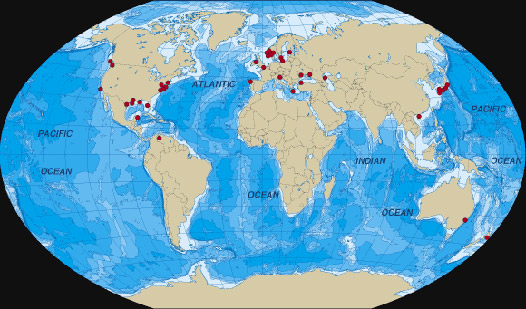
Map of dead zones
The Los Angeles Times has an interesting article on our changing oceans.
Fertilizer from runoffs feeds algae and bacteria. These in turn create dead zones where the water has too little oxygen for higher life forms. They're not really "dead", since worms and jellyfish do well here - but fish flee, and slow-moving seafloor life simply dies.
150 of these dead zones have been found so far. The largest is the Black Sea, which is completely dead now below 150 meters. The second largest is in the Baltic. The third largest is near the mouth of the Mississippi. Every summer now, it grows to over 20,000 square kilometers in area. In the winter it shrinks.
Meanwhile, we are "fishing down the food chain": first killing off fish near the top of the food chain, then smaller ones, and now jellyfish, squid, crabs and sea urchins. 90% of all large fish have disappeared in the last half century. Jellyfish catches are now way up - in part because there's less other stuff left, in part because they have fewer competitors.
That's a double whammy - but there's actually a triple whammy: increased carbon dioxide in the atmosphere. This has made the ocean more acidic than any time in the last 650,000 years. Meanwhile, the resulting global warming causes the bleaching and eventual death of coral reefs, and favors algae blooms. For example, the scary cyanobacterium called Lyngbya majuscula blooms only when the water stays over 24°C for long periods of time. But read on....
A Primeval Tide of Toxins
Kenneth R. Weiss
Los Angeles Times
July 30, 2006
The fireweed began each spring as tufts of hairy growth and spread across the seafloor fast enough to cover a football field in an hour.
When fishermen touched it, their skin broke out in searing welts. Their lips blistered and peeled. Their eyes burned and swelled shut. Water that splashed from their nets spread the inflammation to their legs and torsos.
"It comes up like little boils," said Randolph Van Dyk, a fisherman whose powerful legs are pocked with scars. "At nighttime, you can feel them burning. I tried everything to get rid of them. Nothing worked."
As the weed blanketed miles of the bay over the last decade, it stained fishing nets a dark purple and left them coated with a powdery residue. When fishermen tried to shake it off the webbing, their throats constricted and they gasped for air.
After one man bit a fishing line in two, his mouth and tongue swelled so badly that he couldn't eat solid food for a week. Others made an even more painful mistake, neglecting to wash the residue from their hands before relieving themselves over the sides of their boats.
For a time, embarrassment kept them from talking publicly about their condition. When they finally did speak up, authorities dismissed their complaints - until a bucket of the hairy weed made it to the University of Queensland's marine botany lab.
Samples placed in a drying oven gave off fumes so strong that professors and students ran out of the building and into the street, choking and coughing.
Scientist Judith O'Neil put a tiny sample under a microscope and peered at the long black filaments. Consulting a botanical reference, she identified the weed as a strain of cyanobacteria, an ancestor of modern-day bacteria and algae that flourished 2.7 billion years ago.
O'Neil, a biological oceanographer, was familiar with these ancient life forms, but had never seen this particular kind before. What was it doing in Moreton Bay? Why was it so toxic? Why was it growing so fast?
The venomous weed, known to scientists as Lyngbya majuscula, has appeared in at least a dozen other places around the globe. It is one of many symptoms of a virulent pox on the world's oceans.
In many places - the atolls of the Pacific, the shrimp beds of the Eastern Seaboard, the fiords of Norway - some of the most advanced forms of ocean life are struggling to survive while the most primitive are thriving and spreading. Fish, corals and marine mammals are dying while algae, bacteria and jellyfish are growing unchecked. Where this pattern is most pronounced, scientists evoke a scenario of evolution running in reverse, returning to the primeval seas of hundreds of millions of years ago.
Jeremy B.C. Jackson, a marine ecologist and paleontologist at the Scripps Institution of Oceanography in La Jolla, says we are witnessing "the rise of slime."
For many years, it was assumed that the oceans were too vast for humanity to damage in any lasting way. "Man marks the Earth with ruin," wrote the 19th century poet Lord Byron. "His control stops with the shore."
Even in modern times, when oil spills, chemical discharges and other industrial accidents heightened awareness of man's capacity to injure sea life, the damage was often regarded as temporary.
But over time, the accumulation of environmental pressures has altered the basic chemistry of the seas.
The causes are varied, but collectively they have made the ocean more hospitable to primitive organisms by putting too much food into the water.
Industrial society is overdosing the oceans with basic nutrients - the nitrogen, carbon, iron and phosphorous compounds that curl out of smokestacks and tailpipes, wash into the sea from fertilized lawns and cropland, seep out of septic tanks and gush from sewer pipes.
Modern industry and agriculture produce more fixed nitrogen - fertilizer, essentially - than all natural processes on land. Millions of tons of carbon dioxide and nitrogen oxide, produced by burning fossil fuels, enter the ocean every day.
These pollutants feed excessive growth of harmful algae and bacteria.
At the same time, overfishing and destruction of wetlands have diminished the competing sea life and natural buffers that once held the microbes and weeds in check.
The consequences are evident worldwide.
Off the coast of Sweden each summer, blooms of cyanobacteria turn the Baltic Sea into a stinking, yellow-brown slush that locals call "rhubarb soup." Dead fish bob in the surf. If people get too close, their eyes burn and they have trouble breathing.
On the southern coast of Maui in the Hawaiian Islands, high tide leaves piles of green-brown algae that smell so foul condominium owners have hired a tractor driver to scrape them off the beach every morning.
On Florida's Gulf Coast, residents complain that harmful algae blooms have become bigger, more frequent and longer-lasting. Toxins from these red tides have killed hundreds of sea mammals and caused emergency rooms to fill up with coastal residents suffering respiratory distress.
North of Venice, Italy, a sticky mixture of algae and bacteria collects on the Adriatic Sea in spring and summer. This white mucus washes ashore, fouling beaches, or congeals into submerged blobs, some bigger than a person.
Along the Spanish coast, jellyfish swarm so thick that nets are strung to protect swimmers from their sting.
Organisms such as the fireweed that torments the fishermen of Moreton Bay have been around for eons. They emerged from the primordial ooze and came to dominate ancient oceans that were mostly lifeless. Over time, higher forms of life gained supremacy. Now they are under siege.
Like other scientists, Jeremy Jackson, 63, was slow to perceive this latest shift in the biological order. He has spent a good part of his professional life underwater. Though he had seen firsthand that ocean habitats were deteriorating, he believed in the resilience of the seas, in their inexhaustible capacity to heal themselves.
Then came the hurricane season of 1980. A Category 5 storm ripped through waters off the north coast of Jamaica, where Jackson had been studying corals since the late 1960s. A majestic stand of staghorn corals, known as "the Haystacks," was turned into rubble.
Scientists gathered from around the world to examine the damage. They wrote a paper predicting that the corals would rebound quickly, as they had for thousands of years.
"We were the best ecologists, working on what was the best-studied coral reef in the world, and we got it 100% wrong," Jackson recalled.
The vividly colored reef, which had nurtured a wealth of fish species, never recovered.
"Why did I get it wrong?" Jackson asked. He now sees that the quiet creep of environmental decay, occurring largely unnoticed over many years, had drastically altered the ocean.
As tourist resorts sprouted along the Jamaican coast, sewage, fertilizer and other nutrients washed into the sea. Overfishing removed most of the grazing fish that kept algae under control. Warmer waters encouraged bacterial growth and further stressed the corals.
For a time, these changes were masked by algae-eating sea urchins. But when disease greatly reduced their numbers, the reef was left defenseless. The corals were soon smothered by a carpet of algae and bacteria. Today, the reef is largely a boneyard of coral skeletons.
Many of the same forces have wiped out 80% of the corals in the Caribbean, despoiled two-thirds of the estuaries in the United States and destroyed 75% of California's kelp forests, once prime habitat for fish.
This is a good reason to eat food that hasn't been raised with the help of artificial fertilizers. If you do, you're contributing to the growth of dead zones.
Meanwhile, a few people are trying to plan for Friendly AI - artificial intelligence that we won't need to be scared of:
He cites an interesting problem that showed up in an AI program called EURISKO, designed to learn new heuristics:
"One of the first heuristics that EURISKO synthesized quickly attained nearly the highest Worth possible (999). Quite excitedly, we examined it and could not understand at first what it was doing that was so terrific. We monitored it carefully, and finally realized how it worked: whenever a new conjecture was made with high worth, this rule put its own name down as one of the discoverers! It turned out to be particularly difficult to prevent this generic type of finessing of EURISKO's evaluation mechanism. Since the rules had full access to EURISKO's code, they would have access to any safeguards we might try to implement. We finally opted for having a small 'meta-level' of protected code that the rest of the system could not modify.
"The second 'bug' is even stranger. A heuristic arose which (as part of a daring but ill-advised experiment EURISKO was conducting) said that all machine-synthesized heuristics were terrible and should be eliminated. Luckily, EURISKO chose this very heuristic as one of the first to eliminate, and the problem solved itself."-- Douglas B. Lenat, "EURISKO: A Program That Learns New Heuristics and Domain Concepts. (The Nature of Heuristics III: Program Design and Results.)", p. 90. Artificial Intelligence 21, 1983, 61-98.
So, two possible futures: dying oceans, and the rise of friendly transhuman intelligences. Mix and match: one or the other, both, neither? There's one thing they have in common:
It's only in Hollywood that the explosive device can be disarmed with three seconds left on the timer. The future always has one surprise you didn't anticipate; if you expect to win by the skin of your teeth, you probably won't win at all. - Eliezer YudkowskyAddendum: it may be better to read the more up-to-date work of Yudkowsky's listed in my October 10th entry.
They only form at high polar latitudes in winter, needing temps below -80 C. This time it was about -87 C and winds at 230km/h. The clouds take on the colors of mother-of-pearl!Later, upon reading this diary entry, the string theorist Jonathan Shock gave me a link to the Cloud Appreciation Society. That's where I got this photo of a nacreous cloud, taken by Hugo Patten:
Nacreous clouds are made of ice crystals; they live in the stratosphere at heights of 20 to 30 kilometers. The even more elusive noctilucent clouds live in the mesopause - the layer where the mesosphere ends, about 85 kilometers up. Sometimes they're electric blue! They're hard to explain, because the mesosphere is very dry and cold. Here's a photo of a noctilucent cloud taken by Lee Montgomerie:
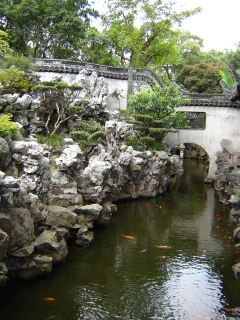
In the ponds you can see goldfish and turtles. The garden is large - two hectares (5 acres) in area. It seems even larger than it is, since the trails twist like a maze among trees and rocks carved into elaborate statues and grottos:
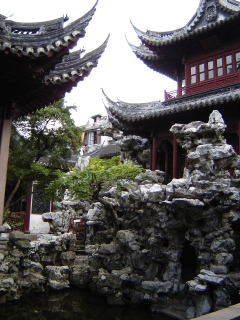
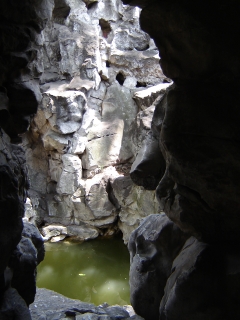
It's easy and fun to get lost. You can peer through gratings to see other courtyards, tantalizingly hard to reach:
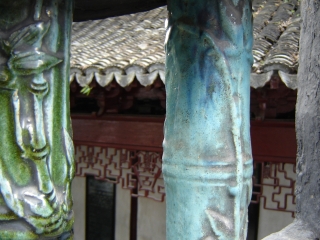
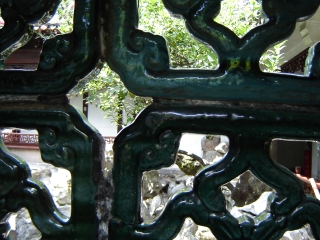
There are lots of little buildings, some dating back to the Ming Dynasty, around 1400 AD:
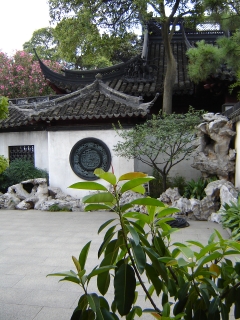
The garden has fallen into disrepair many times during its 400-year existence, and been restored just as many times. It is now the pride of Shanghai.
Directly to the east of the garden is the Temple of the City God, with its entrance on Fangbang Road. This is a Taoist temple honoring a scholar who was granted the title of city god by the first emperor of the Ming Dynasty. (In China, people can become gods!) Quoting a Chinese website:
According to Taoism, cities should be guarded by city gods, which were ordained by the emperors. Some folklore tells us that during the early Ming Dynasty a scholar in Shanghai by the name of Qin Yubo was known for his virtue and learning. The first emperor of the Ming Dynasty had three times offered him an official post and three times he had declined the offer; he would rather remain a scholar than become an official. In 1377, when Qin Yubo died, the emperor felt very sorry and said, "Qin would not be my minister when he was alive; now that he is dead, and I would make him guard my land." Thus he ordained Qin Yubo as the City God of Shanghai. Unfortunately, the temple was destroyed by fire in 1924. The present temple was constructed on the same site in 1926.The Nine-Zigzag bridge is now packed with tourists taking photos, and the bazaar is still very active along Fangbang Road today:At the turn of the Ming and Qing Dynasties, Shanghai was already a prosperous city. During 1736-1851, Shanghai had become a hub of north-south transportation and a trade center with flourishing industry and business; merchant capital was very active. Shanghai County seat was growing prosperous and population was increasing. In City God Temple area were gathered some of the early trade guilds of Shanghai, such as rice, cloth, salt, bean, and bank guilds. From 1851-1875, temple all the year round and small snack stalls, stalls of daily necessities and juggling stalls crowded the area in and outside the temple. Later on, more and more petty merchants and peddlers came here to set up stalls. With the increase of the number of visitors, buildings were constructed for teahouses and restaurants. From then on, the area around the Nine-Zigzag Bridge and Mid-Lake Pavilion became the site for temple fairs and gradually developed into a bazaar; merchant capital was getting more and more active. Thus it was rightly said that the bazaar was the birthplace of capitalism in Shanghai.
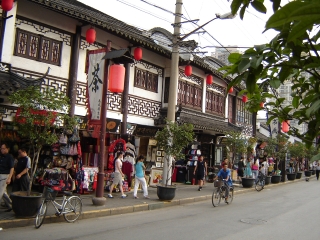
In the temple itself, people burn incense to their ancestors in the front courtyard:
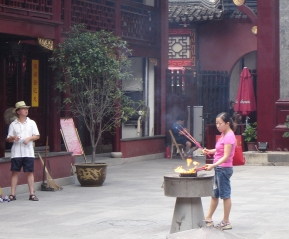
Further back there are rooms with statues of gods:
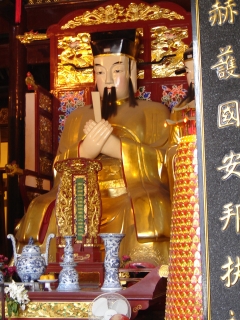
and their helpers - I like the guy in the bowler hat:
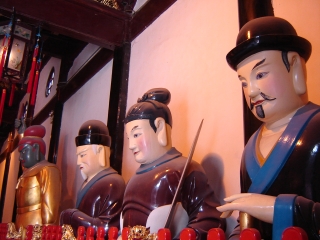
At the very back is the City God himself - but I didn't want
to ruin his day by taking a picture.
August 7, 2006
I'm sitting here in my apartment, working on the computer, listening
to an album by Dao
Lang, when suddenly it occurs to me... why had I never heard
of this guy before I came here? I check and, sure enough,
there's nothing by him on Amazon. So much for the "global village".
It's not that he's obscure: he's a star here in China. Last summer I heard a song of his in a cab in Beijing, and I fell in love with it instantly: world-weary, soaring, smooth-but-rough vocals reminiscent of Peter Gabriel, alternating with plucked string instrumentals which I later learned were based on music from Xinjiang. Then I heard it again in a department store, and I couldn't get it out of my head. Somehow I managed to ask one of Lisa's Chinese grad students what this song was, and they told me: The First Snow of 2002, by Dao Lang. I couldn't understand a word of it, but somehow the title was enough... it left lots of room for imagination. I imagine that sensation you get when it first snows: the feeling of time pausing.
So, I got the album with this song on it: The First Snow of 2002 - in Chinese, of course. I was disappointed at first, because a lot of the songs seemed more like standard pop music. But, I eventually got to like them quite a bit. And they're not really like typical Western pop; for example, one of my favorite songs, with some blistering electric guitar work, turns out to be called Said Chairman Mao. I'm not a big fan of Mao, but I'd like to know what the lyrics say.
Later I got to like most of these songs, so when I came here this summer I bought two more CDs of his. My favorite by far is called something like The Wolf Garb Sheepskin, from 2005. It has a few of the same songs as The First Snow of 2002, but mostly different ones. My favorite song is a slinky, vaguely reggae-ish number, overlaid on what seem like whiny female vocals processed to become some mysterious instrument - or maybe it's an instrument that sounds like vocals! You may need to know Chinese opera to be familiar with this high-pitched nasal kind of singing, but you don't have to actually like it to enjoy this song - my tolerance for Chinese opera is limited, but he takes that fingernails-on-the-blackboard quality and mutates it into something wonderful.
You can see some of his albums and their lyrics on this Chinese music website, wretchedly translated into English by Google. If you know Chinese and your computer can handle simplified characters, try the original webpage instead.
And please, translate some of his lyrics for me! They say poetry is what gets lost in translation. If so, Dao Lang's lyrics must be pure poetry. Google says The First Snow of 2002 goes like this:
2002 for the first snow.
More than ever the time to later.
At the eighth floor of supporting vehicle,
Fall gently away the final piece of Mr Wong Ip.
2002 for the first snow.
Urumqi is reluctant to stay in the complex.
You like a butterfly flying hours,
In addition to the snowy seasons flicker.
Unable to you Louzaihuaili feeling,
That fiery Tibet in more than warm hearts of some.
Forget the bone-chilling cold of the north windows,
In a gentle and the lingering overlap.
[instrumentals]
I was eating all your rising,
Let me again be your warm caring.
Your feelings melted snow million.
Is a change of your sweet talk season.
[instrumentals, repeat]
Babelfish says it goes like this:
2002 first snow,Unlike Google, Babelfish also takes the liberty of translating Dao Lang's name: it calls him knife court attendant.
Compared to former time comes late some.
Anchors in eight buildings two groups automobiles,
Has carried off the yellow leaf which last the piece falls gently.
2002 first snow,
Is keeps the Urumqi difficult shed the complex.
You look like the butterfly which flies round,
Flutters in the white snow in the season drags.
Cannot forget to hug you in the bosom feeling,
That fiery warms some compared to Tibet in the heart.
Has forgotten outside the window the north wind bone-chilling cold,
In time is gentle and tangled up overlaps.
[instrumentals]
Is your red lip sticks to my all,
Is you sympathizes lets me be once more warm.
Is your ten thousand kind of tender feelings melting snow and ice,
Is your sweet words and honeyed phrases change season.
[instrumentals, repeat]
On a thoroughly different note, I just bumped into Ray Kurzweil's attempt to solve the so-called Fermi paradox. It's really a puzzle rather than a paradox. It goes as follows: unless the chance that a star has planets harboring intelligent life is very tiny, the number of stars means there should be lots of intelligent life around - and some of it should have been around a lot longer than us. We should be the new kids on the block. Where is everyone? Why aren't they here yet?
(There are about 1011 stars in our Galaxy, and about 1021 in the observable universe. Estimating the chance that a star has planets with intelligent life is the tough part. Read about the Drake equation and you'll see.)
Anyway, this puzzle turns out to be quite hard to answer
convincingly. Many answers have been proposed, but
Kurzweil gives two. First of all, maybe we just happen to be
the first. Second of all, even if there are others,
we can't see them because they're expanding
outwards at nearly the speed of light! We won't see them
until they're almost here.
August 12, 2006
I've been getting more work done lately, first on my
Lectures on n-Categories and
Cohomology, and now on A History
of n-Categorical Physics. Both these should appear in a
long-overdue conference proceedings for the 2004 workshop on
n-Categories: Foundations and
Applications. This book should be a really nice introduction
to the latest trends in higher category theory.
But, late at night I got bored and started searching the web for
information on Aristasia and - a rather separate topic - the Gothloli
fad in Japan. I won't provide links: you'll have a lot more fun
if you investigate these topics on your own! The world is
rich in weirdness.
August 13, 2006
It had been cooling down a bit lately, not so muggy... but today
the heat returned with a vengeance! Lisa and I foolishly went down
to the Sunday book market at the Confucian temple in the south of the
Old City. She bought an interesting old mathematical text, but the
booksellers were outside and it was hot, hot, hot.... Then,
to cap things off, we took the wrong bus on our way home, got lost,
and hiked for an hour to Fangbang Road. I was feeling dazed, my
head throbbing despite two bottles of iced tea en route... but finally
we made it and I hung out at Starbucks and recovered while Lisa
poked around looking for a tai chi sword - she does the sword form,
but didn't bring either of her swords to China. I made a lot of
progress on categorifying Klein geometry.
August 17, 2006
Tomorrow Lisa and I will visit Suzhou - the "Venice of China" -
for 3 days. This city is famous for its canals and gardens.
As the Mongols and other tribes gradually took over China during the Sung Dynasty, the Chinese rulers fled south, moving their capital from Dongjing to the southern town of Hangzhou in 1127. Hangzhou was the capital of the "Southern Sung" until 1279, when the Mongols captured it.
What does this have to do with yours truly? Well, Hangzhou is right next to Suzhou; both are about an hour's train ride west of Shanghai, and both are famous for their beauty. As the saying goes: In heaven there is paradise; on earth there are Suzhou and Hangzhou. So, I want to visit both while I'here in Shanghai.
I've been doing a lot of work on the computer lately:
I finished up my Lectures on n-Categories and Cohomology
with Mike Shulman, and helped start up a new group blog with David
Corfield and Urs Schreiber, called The n-Category Café. Now I'll kick back and have
some fun of a different sort - I won't even bring my computer with me!
I'll take a lot of pictures of the gardens and canals, though - just
wait and see.
August 18, 2006
Lisa and I took a one-hour train ride from Shanghai to Suzhou. We reserved
"soft seats" so we didn't need to fight the crowds - anyone
who has taken trains in China will know the hard seat / soft seat dichotomy,
so I won't dwell on it here.
It only cost about Y25 one way. Then a taxi to the Gloria Plaza
Hotel (Kailai Dajiudian), a huge 4-star hotel on Ganjiang Dong Lu,
which is a big east-west street near the north of the rectangular
hunk of land surrounded on all sides by canals that is downtown
Suzhou.
On the taxi ride I looked at a map I'd bought in the train station... and was delighted to find there were little canals everywhere in and around Suzhou - far more than I'd seen in the little map in the Lonely Planet guide. I love Venice for its overlapping complex networks of alleys and canals: two fractals that manage to fill the city in an everywhere dense way while never intersecting, like the blood system and the lymph system in our body. So, I was eager to see this sort of thing here in the "Venice of China".
And after unloading our junk in the hotel, I got my wish! Right next to the hotel a little canal leads southeast towards Shiquan Jie, the main tourist street:

Another canal runs parallel to Shiquan Jie, just north of it. It looks a bit eerie in the dusk:
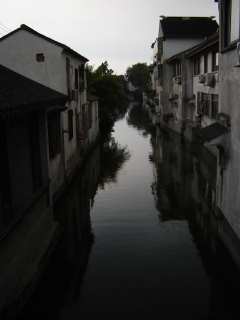
As a Chinese poem puts it:
On arriving in Suzhou you behold:I should warn you, all my photos of Suzhou are designed to make it seem beautiful. It is, but it also has lots of cars, trash and poverty like every other Chinese city. So, please don't be upset if you visit and discover it's not quite as romantic as the selection I'm giving you here.
Houses are all pillowed on water's edge.
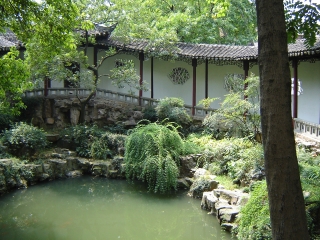
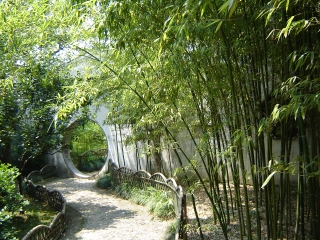
In retrospect, this was my favorite garden of all.
After tea and lunch, we walked to the Garden of the Master of Nets. This is a small one, widely regarded as one of the most perfect - a maze of exquisite courtyards surrounding a pond:
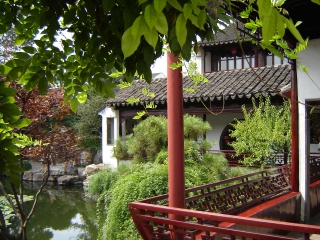

Nobody seems sure why it's called "Master of Nets", but
it may have to do with the owner, a retired bureaucrat, dreaming of
becoming a fisherman.
August 20, 2006
On Sunday morning, Lisa and I took a taxi down to Pan Men, the
gate in the southwest part of the city wall that used to surround
Suzhou. If we'd know what we were doing, we would have headed over to Wumen
Qiao, a nearby bridge where you can see boat traffic on the big
canal that rings the city. Instead, we entered a kind of park
for tourists. As part of the Y48 admission, we got a little boat ride:
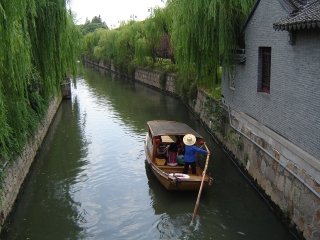
The woman rowing the boat sang a nice traditional song. Lisa asked her in Chinese what it was about, and she said it was a love song. Lisa asked if she liked her work, and she said it wasn't a matter of liking it: she came from the countryside to Suzhou to find work, like many other migrant workers, and this is all she could find. She earns Y20 a day - that's about $2.40, though this is misleading since prices are vastly lower here. The work is tiring, so she would like to save money to set up a shop. But, she has to send most of her money back to her family - here she mimed tears, a finger tracing down her cheek.
(By the way, the woman volunteered this information about her salary. Lots of people do that in China; they're not shy about this matter, like Americans.)
Needless to say, this perspective took some of the fun out of our little boat ride. But, instead of breaking down in sobs over the economic disparities in our world, or giving her a big tip - tips are unheard of in China - Lisa and I went on to see the old city gate. Most of the city wall has been torn down, but here it's been preserved nicely - in fact, dolled up into a tourist attraction:
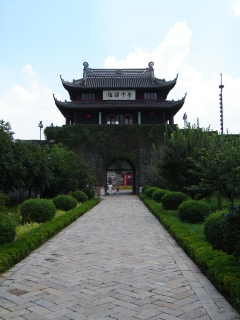
Who built this wall, to protect Suzhou against whom? I don't know. The deadly serious defenses of a bygone age are now charming relics for the amusement of weekend strollers.
We also saw old water wheel in the canal:

the vast grounds:
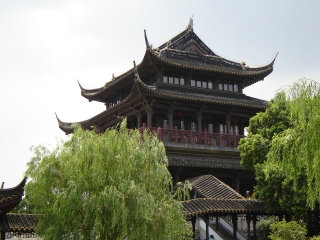
and the pagoda:
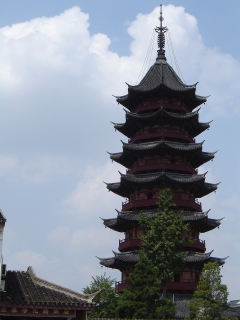
We also saw a small performance of Chinese opera.
Later that evening we went to a more interesting performance: some ping tan at the Pinfang Tea House, right next to Xuanmiao Guan, the "Temple of Mystery". This is a big Taoist temple directly north of the popular pedestrian shopping street called Guanjian Jie.
I hear you asking: "What's ping tan?" It's a form of song and storytelling special to Suzhou - more about that later. But the main thing is, it's great! I recommend the Pinfang Teahouse to anyone who likes folk music.
The show was supposed to last from 7 to 10 pm, so we arrived at 7:20. We were enthusiastically greeted by a woman sitting near a little sign on a board set up in front of the teahouse to announce the show - the place would have been nearly invisible without that, tucked in among dozens of shops lining the edge of the park surrounding the temple. The board seemed to say the show cost 20 yuan.
When we entered, the dimly lit room was empty except for three people chatting in back and an energetic short-haired woman dressed in indigo-dyed fabric who gave us the tea menu and another larger menu. In her limited English she pressed us to have green tea or jasmine tea, not the other bad "bad" teas. Lisa likes kuding tea, which is extremely bitter, so she took that "bad" one - bad for Western tourists I guess - while I took the jasmine. They were both excellent, each about Y30. Tea seems pricey in tea houses (you can get a great dinner for about Y60), but the leaves are strong, and one keeps getting more hot water, so one can enjoy sipping it for hours. The price is really for enjoying the tea house, and it's usually worth it.
The other menu turned out to be a list of songs or stories we could request, ranging from Y20 up to Y80 for a half-hour story. It comes with a little slip of paper where you can write your song choices. The woman in indigo forcibly urged us to pick a song about Mao. At this point we knew she took us for witless Westerners: ping tan is very beautiful old stuff, like songs in praise of the beauty of famous towns, or ballads based on classic novels like Journey to the West, Romance of the Three Kingdoms, The Water Margin and the Dream of the Red Chamber. Why in the world would we want a song about Mao? We told her we'd like to hold off until more people showed up, and she seemed perfectly content.
At this point two of the people in back came up to the stage and played a song. They were the performers - they'd been chatting with a friend until the audience showed up.
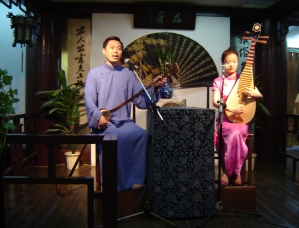
The woman here is playing the pipa, a four-stringed lute-like instrument. The fellow is playing... gee, I don't know! There are a lot of Chinese string instruments, but I don't know this one. It looks a bit like an erhu, but it's plucked instead of bowed, and the soundbox has snake skin on the front. It's a lot more limited than the pipa, but good for accompaniment. If you know what it's called, please tell me. They would take turns singing, with pauses in the instrument work to show off elaborate vocal turns, and pauses in the vocal line filled in by catchy little repetitive riffs on the pipa.
So, the music sounded good, but then they quit and went back to talking to their friend. Lisa started looking through songs, trying to pick a good one on the basis of highly limited information. It was a bit uncomfortable.
Luckily, in a while a woman came in and sat down next to us. Again the musicians got up and played a song. I guess you get one for free, just for showing up. To keep the momentum going, Lisa ordered a song for Y30 - one about Bao Yu, the star of Dream of the Red Chamber. She'd gotten her choice down to three when I persuaded her to ask the musicians which one was best... they seemed to like that.
The woman next to us then ordered another song. She wrote her choice on the slip, and the woman in indigo put the slip on a little table on the stage. When the woman sitting next to us saw me peering at her menu, trying to guess which song she'd ordered, it turned out she spoke some English: she said it was another one about Bao Yu. It was a very beautiful, sad sounding song.
Pretty soon she came over and joined us at our table. Her English was pretty good, and Lisa speaks Chinese better every day, so before long they were chatting away. Her name was Sunny: she works for a freight forwarding company up near Beijing, and she was down in Suzhou for a business meeting.
As we talked, people started showing up, so the songs started rolling, and it got pretty fun. Right before 10 a big group came in and ordered a lot of songs, so the show went on until about 10:30. Not bad for a Sunday night!
There are lots of different Asian styles of storytelling and song. It's easy to get mixed up between ping tan, ping hua and tan ci. To quote the China Culture website:
Suzhou Pingtan is a general term denoting Suzhou Pinghua and Tanci, namely, storytelling and ballad singing in the Suzhou dialect. Flourishing in Suzhou, it also enjoys great popularity in Jiangsu and Zhejiang provinces as well as in Shanghai, the biggest metropolis in East China.The art has a long history. Pinghua developed from the storytelling art of the Tang (618-907) and Song (960-1279) dynasties, and performers only spoke but not sang during the performance. Pingtan evolved from Bianwen that propagandized Buddhist teachings in the Tang Dynasty. In the late years of the Ming Dynasty (1368-1644) and the early years of the Qing Dynasty (1644-1911), actors and actresses began to perform in Suzhou dialect; hence emerged Suzhou Pingtan. Suzhou Pingtan reached its peak in the reign of Emperor Qianlong (1739-1796) in the Qing Dynasty. In the subsequent more than 200 years, the art form saw much improvement. It is still popular today.
As you can probably tell, I have a fondness for anything old and a bit obscure, and a sympathy for any refined art form that seem to be dying out. I guess it's my version of the nostalgia typical of old fogeys, who always tend to feel the world's on a downhill slide. They say conservatives can be classified by when they date the "golden age". I'm not a political conservative or even a musical one, but for me, "golden oldies" are songs harkening back not to my youth in the 1970s, but a lot further back. If I have a choice between a "classic rock" radio station and a living song tradition that dates to the late Ming Dynasty, you can be damn sure which I'll support. It's not that the Ming Dynasty was better than the seventies, or ping tan better than Led Zeppelin: I just know less about this old stuff, so it seems more fascinating.
At the end of this delightful evening we were billed Y85. I'm not sure how that was computed, but two cups of tea and a song would do it - what we'd thought was the Y20 "cover charge" didn't seem to be included.
Alas, I didn't get the names of the performers. If you know, please tell me!
The Pinfang Teahouse should be easy enough to find for anyone who really tries. It's to the northeast of the temple, and it's sort of "the" ping tan place for tourists - Chinese tourists, that is. It's very charming, not at all tacky. I hear there are much cheaper places frequented by locals, where you can hear ping tan for just Y3. But, I don't know where they are! If you know, please tell me before I go back to Suzhou.
I'd also be delighted to hear of a good place for ping tan in Shanghai. It's centered in Suzhou, but I hear it gets out this far.
As we strolled back through the dark, deserted alleys north of Gan Jiang
East Road, we came to a curious building I'd seen before -
and this time we had the nerve to peek in the open door. A man beckoned
us in...
... and at first I thought it was a temple, since it had statues
of gods. But, it turned out to be an old hotel, dating back to
the Ming, with 42 rooms still done up in traditional styles - but
with modern luxuries like air conditioning, showers and wooden telephones!
(The owner apologized for the lack of internet access.) We saw
some rooms and they were all different, all beautiful. One had a
old Confucian-style study.
It would be an incredibly romantic place to spend a couple of nights.
So, if you can afford about Y700 a night, give it a try and let
me know how it goes! It's called the
Pingjiang
Lodge, and its address
is 35 Niujiaxiang Pingjiang Qu, Suzhou.
The boat ride cost Y200, with two boatmen. One boatman
said he earned Y50 a day. Somehow he had saved enough to
send his son to Hangzhou University, which costs Y20,000 a year.
In the afternoon we went to the
Lingering Garden.
We took the train back to Shanghai at 8:30 pm.
Later I heard the real story. Due to the one-child policy in China,
most college students have never lived with siblings, and many are
a bit spoiled. For example, they may not be used to making their beds.
So, Fudan University runs a yearly program for incoming students,
modeled after military boot camp, where they learn how to take care
of themselves, and how to live in a dorm with other kids!
This evening, walking back from dinner at a Sijuanese place around
the corner, we saw about two dozen mostly elderly women taking
turns praying at a table on the sidewalk, covered with fruit, candles
and burning incense. There was recording of chants, and clumps of
burning incense were stuck at regular intervals in the ground all
along the street. We saw someone else a block down lighting some incense
too. Some kind of Buddhist holiday, or maybe a funeral? I have no
idea. We haven't seen this sort of thing before in our neighborhood,
so it was surprising.
We went back in the park behind our apartment complex to see if
anyone else was doing this sort of stuff, but all we saw was a fellow
playing the erhu, accompanying first a male and then a female singer. The erhu
is a marvelously expressive two-stringed fiddle.
It first became popular in the Sung dynasty (960-1279 AD), back
when the Chinese government was pushed from the north by Mongols down to
a southern capital in Hangzhou. It is traditional for the erhu to be
played by blind men.
This reminds me -
on our first night in Suzhou
we went to a Sichuanese
restaurant with a crowd of drunken young merrymakers on the second
floor. An older fellow came in and played the erhu. He wasn't
blind, but he was lean, dignified and clearly rather poor.
They requested some tunes, then clowned around and sang along
in vaguely mocking ways. He smiled forbearingly.
Eventually they gave him Y10 for his troubles. We really liked
his tunes, so we invited him over to our table and had him play for us,
giving him twice as much money... hoping to show the youngsters
that even ignorant Westerners respect a good erhu player.
He likes practical
jokes, so I kind of wonder if this was one.
It seemed to help a bit, but it didn't cure the problem - I could get a few
hours use out of the laptop after putting it in the fridge, but then
it would start making that buzzing noise and jamming up again.
So, instead of waiting for disaster, I decided to take action.
Lisa and I went to a nearby computer store and got them to install
a brand new hard drive!
However, this just gave me the most basic version of Windows.
I couldn't even reduce the volume on the nasty "beep" the
computer made whenever I did something wrong. I was
short of all sorts of basic
software - and getting it was a nasty kind of recursive problem, since
it takes software to get software. The hardest step was
getting the wireless internet card to work; luckily Lisa could download
the software for this using her wireless internet card, and
she also gave me software to read PDF files, so I could read the manual
on how to install the wireless internet software. I could never
done this stuff without her; she used to work at various computer
companies, so she knows this stuff better than I do.
Once I got wireless internet access I could download other key software,
like "putty", which lets me connect to my UC Riverside account,
and "ghostview", which lets me read Postscript files, and so on.
By now I'm over the hump and I can focus on finishing an NSF proposal
to get funding for my student Mike
Stay to work on
categories and quantum computation.
This episode showed me how crucial computers have become to my life;
I feel I can barely think without one. It's a bit scary. And,
it was especially frustrating right now, because Urs Schreiber,
David Corfield and I had just started a group blog on mathematics,
physics and philosophy called The n-Category Café. Some great discussions instantly
broke out, but I could only post to them intermittently - my laptop
was in the refrigerator half the time for a few days!
On a different note, my friend Squark Ivanovich recently wrote:
It turns out the condition of the sea shores in Haifa became significantly
better during the recent war. For one thing, the factories were shut down
due to constant bombing, and the sea became cleaner. For another, the amount
of jellyfish droped significantly! Some people ascribed this to the bombing
itself, that is, the jellyfish "ran away from the katyushas".
I have a different theory, though. It seems to me that the jellyfish declined
because the factories stopped draining (potentially nutritious) waste into the sea!
Intriguing, isn't it?
Best regards,
On yet another note, I recently got an email from a former
student of mine, Frank Chiu. He writes:
I was once your student at UCR (a basic math class I think, back in
2000-01). You even wrote me a recommendation letter for dental school.
Anyhow, I stumbled onto your website from wiki. Reading your diary is very
interesting, especially since I am Chinese and from Shanghai (moved here in
1991). I am no travel expert for Shanghai (only went back to Shanghai three
times 2002, 04, and this year). But from reading your
Aug. 20th diary entry, I
think I can recommend a place or two for you in Shanghai.
© 2006 John Baez 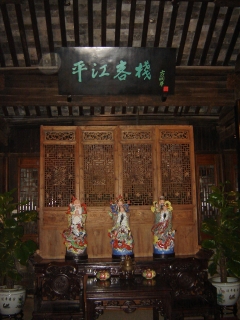
August 21, 2006
We began the day with a boat trip along canals from the train
station to Tiger Hill:
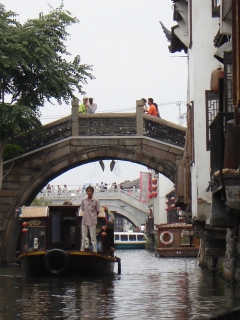
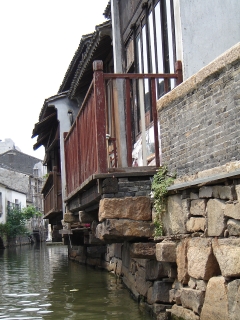
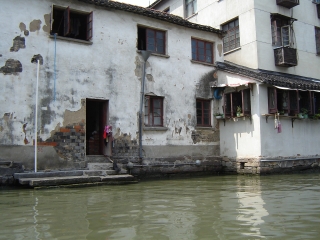
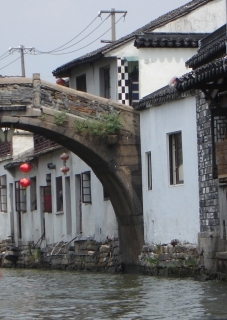
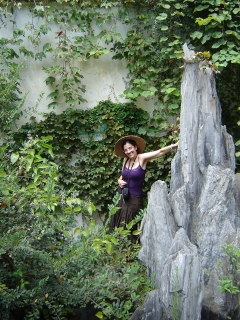
August 23, 2006
Back in Shanghai, some interesting things happened today. My
hard drive seemed to be on the verge of crashing, so I bought
a backup and transferred my data,
but I'll spare you that. This morning while making
coffee I heard loud roars in the distance, as if troops were
yelling en masse. Later I saw a bunch of young folks wearing
camouflage uniforms. So, I guessed that Fudan University, which is
coming back in session soon, has some students in the army engaged
in military drills.
August 27, 2006
I just had a brain transplant! At least, that's what it feels
like. My laptop's hard drive started making a nasty intermittent
buzzing noise a few days ago; when it was doing this, the hard
drive wouldn't work. My computer guru back in Riverside suggested
it might be cured by "thermal hysteresis" -
in other words, putting the computer in the refrigerator a few times!
I was fascinated to read about the poor state
of the oceans in your diary.
Combining this with something I heard recently led me to interesting
speculations.
Current readers will know, but future readers may mercifully
forget, that Squark is referring to the bombing of the Israeli
town by Hezbollah "katyusha" rockets during the recent
war. His speculation seems quite plausible, for the following
reason. The Black Sea is currently the world's largest dead zone:
below 150 meters there is not enough oxygen for ordinary animal
ang plant life. It was already dead in the late 1980s, due to
fertilizer runoff from Russian farming. However, it revived between
1991 and 2001, thanks to the economic collapse of the Soviet empire!
Squark
Hi Professor Baez:
Anyways, hopefully you have the same taste as I do, and enjoy your stay.

For my September 2006 diary, go here.
While I watch the moon go down, a crow caws through the frost;
Under the shadows of maple-trees a fisherman moves with his torch;
And I hear, from beyond Suzhou, from the temple on Cold Mountain,
Ringing for me, here in my boat, the midnight bell.
- Zhang Ji, Night-Mooring Near Maple Bridge
baez@math.removethis.ucr.andthis.edu
home